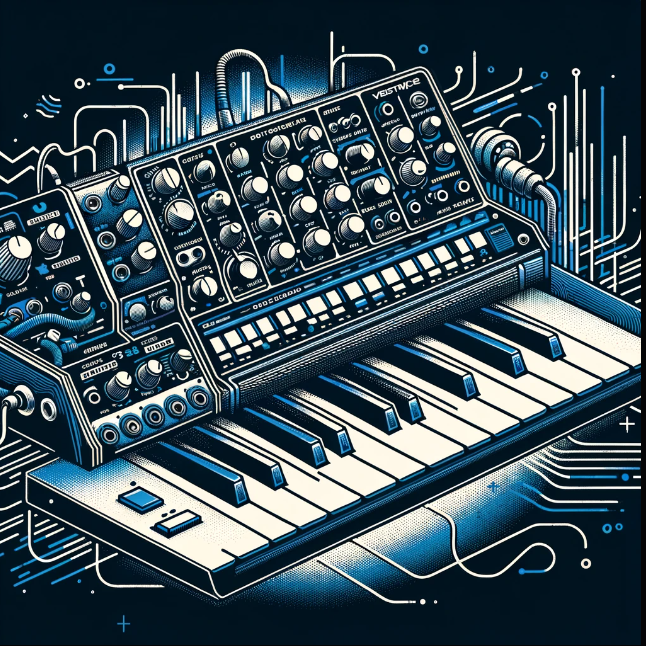Originating in the '90s, Acid Breaks combines Acid House with the tempo of breakbeat. Central to this genre is the legendary Roland TB-303 synthesizer, whose "acid squelch" has become synonymous with an era, shaping tracks from Phuture’s “Acid Trax” to 808 State’s “Pacific State.”
What are Acid Breaks?
Acid Breaks fuse distorted basslines, brisk tempos, syncopated rhythms, and the iconic Roland TB-303 synthesizer into a captivating blend. This genre excels in evoking a trance-like state through its repetitive acid sequences, maintaining a dance floor vibe that has been going for decades.
Sampling Acid Breaks: The Gateway to Innovation
Integrating Acid Breaks into tracks is more accessible than ever. Sample pack libraries and platforms such as Sample Focus provide the tools needed to incorporate acid-inspired elements into modern compositions, whether aiming for a '90s authenticity or a fresh twist.

Advanced Techniques for Sample Manipulation in Acid Breaks Production
Here's how to implement chopping, resampling, and layering, along with the application of granular synthesis and spectral analysis, to refine your Acid Breaks.
Chopping
Chopping involves segmenting a sample into smaller parts to rearrange or repeat specific sections, creating a new rhythmic pattern or melody.
How to Chop:
- Isolate: Use your DAW to isolate the segments you want to manipulate. Look for transients, or sharp changes in the waveform, as natural cutting points.
- Rearrange: Experiment with the order of these segments. Changing their sequence can drastically alter the vibe of your track.
- Quantize: To ensure tight rhythm, quantize the chopped samples to snap them into your track's tempo.
Resampling
Resampling is the process of recording a processed sound back into your DAW, creating a new sample. This allows further manipulation without losing the initial processing work.
How to Resample:
- Process: Apply effects or changes to your original sample.
- Record: Bounce this processed sound back into your DAW as a new audio file.
- Manipulate: Now, treat this new sample as raw material for further editing.
Layering
Layering combines multiple samples or sounds to create a richer, fuller effect.
How to Layer:
- Selection: Choose samples that complement each other. Pay attention to the frequency spectrum to ensure they don’t clash.
- EQ: Use EQ to carve out space for each layer. For instance, if layering basslines, ensure they occupy different frequency ranges.
- Balance: Adjust the levels of each layer to create a cohesive sound. Often, subtle blending works best.

Granular Synthesis
Granular synthesis breaks down samples into tiny grains, which can then be manipulated individually, offering a vast landscape of sonic possibilities.
How to Use Granular Synthesis:
- Choose a Plugin: Select a granular synthesis plugin compatible with your DAW.
- Load Sample: Import your Acid Break sample into the plugin.
- Manipulate Grains: Adjust parameters such as grain size, pitch, density, and pan to transform the sample into something entirely new.
Spectral Analysis
Spectral analysis allows you to see and manipulate your sound in the frequency domain, providing a detailed view of its harmonic content.
How to Apply Spectral Analysis:
- Analyze: Use a spectral analyzer in your DAW to identify the frequency content of your sample.
- Process: Employ spectral processing tools to isolate, enhance, or attenuate specific frequencies. This can include spectral filtering to remove unwanted frequencies or spectral morphing to blend different sounds together.
Processing and Manipulation Techniques for Acid Breaks
To transform Acid Break sample you need to apply processing and manipulation technique. Let's explore how distortion, filtering, and additional processing techniques can be applied to achieve this transformation.
Distortion
Distortion adds harmonics, enhancing the richness and color of your samples. It can range from subtle warmth to aggressive crunch, providing a spectrum of tones to explore.
How to Apply Distortion:
- Choose a Distortion Type: Overdrive, saturation, bit crushing, or tube distortion are popular choices. Each offers a different texture.
- Apply Sparingly: Start with a low mix or drive setting and gradually increase until you find the sweet spot. Too much distortion can mask the original character of your sample.
- EQ Post-Distortion: Use EQ to tame any harsh frequencies or to highlight the newly added harmonics.
Filtering
Filters sculpt the sound by removing or boosting certain frequency ranges. High-pass, low-pass, band-pass, and notch filters can dramatically alter the character of your Acid Breaks.
How to Use Filtering:
- High-Pass Filtering: Removes low-end frequencies, making tracks cleaner, especially when layering multiple elements.
- Low-Pass Filtering: Cuts high frequencies, useful for creating mellow, subdued sounds.
- Resonance: Adjusting the resonance control can emphasize frequencies at the filter's cutoff point, adding a distinctive peak.
- Automation: Automate filter cutoff and resonance for dynamic sweeps and movements, a staple in Acid Breaks production.
Additional Processing Techniques
Beyond distortion and filtering, several other techniques can enhance your Acid Break samples:
- Compression: Use compression to even out levels and add punch to your drums and acid lines. Experiment with attack and release settings to either tighten up the sound or give it a more pronounced transient.
- Reverb and Delay: Spatial effects like reverb and delay can add depth and movement. Use short, gated reverbs for a vintage feel or long, modulated delays for a more expansive soundscape.
- Modulation Effects: Phaser, chorus, and flanger effects can add movement and interest to static sounds. Modulating parameters like rate and depth in real-time can create evolving textures.
- Sidechain Compression: Pumping effects, created by sidechaining your acid line to the kick drum, can enhance the rhythmic drive of your track, making it more dynamic and engaging.
Sample Packs and Presets
Kickstart your Acid Break endeavors with dedicated sample packs and presets designed to encapsulate the genre’s essence. Sample Focus is a great foundational platform for track construction.


Crafting Your Own Acid Breaks
Equipped with a DAW, virtual instruments, and a MIDI keyboard, the creation of Acid Breaks is at your fingertips. Opt for a virtual TB-303 plugin or analogous synthesizer for those quintessential basslines. Effective drum patterns and sequences are paramount—aim for a groove that complements the acid lines and maintains momentum.

Acid Breaks Across Genres
The reach of Acid Breaks extends into hip-hop, techno, drum and bass, and pop, showcasing the genre’s adaptability. Artists like Aphex Twin, Bicep, and Autechre have integrated Acid Break elements into their music, highlighting the genre’s broad appeal and timeless nature.
Final Words
Acid Breaks stand as a formidable asset in modern music production, merging nostalgia with innovation. By mastering sample manipulation and tapping into the creative depths of this genre, you can impart your tracks with the enduring energy of Acid Breaks.








Comments